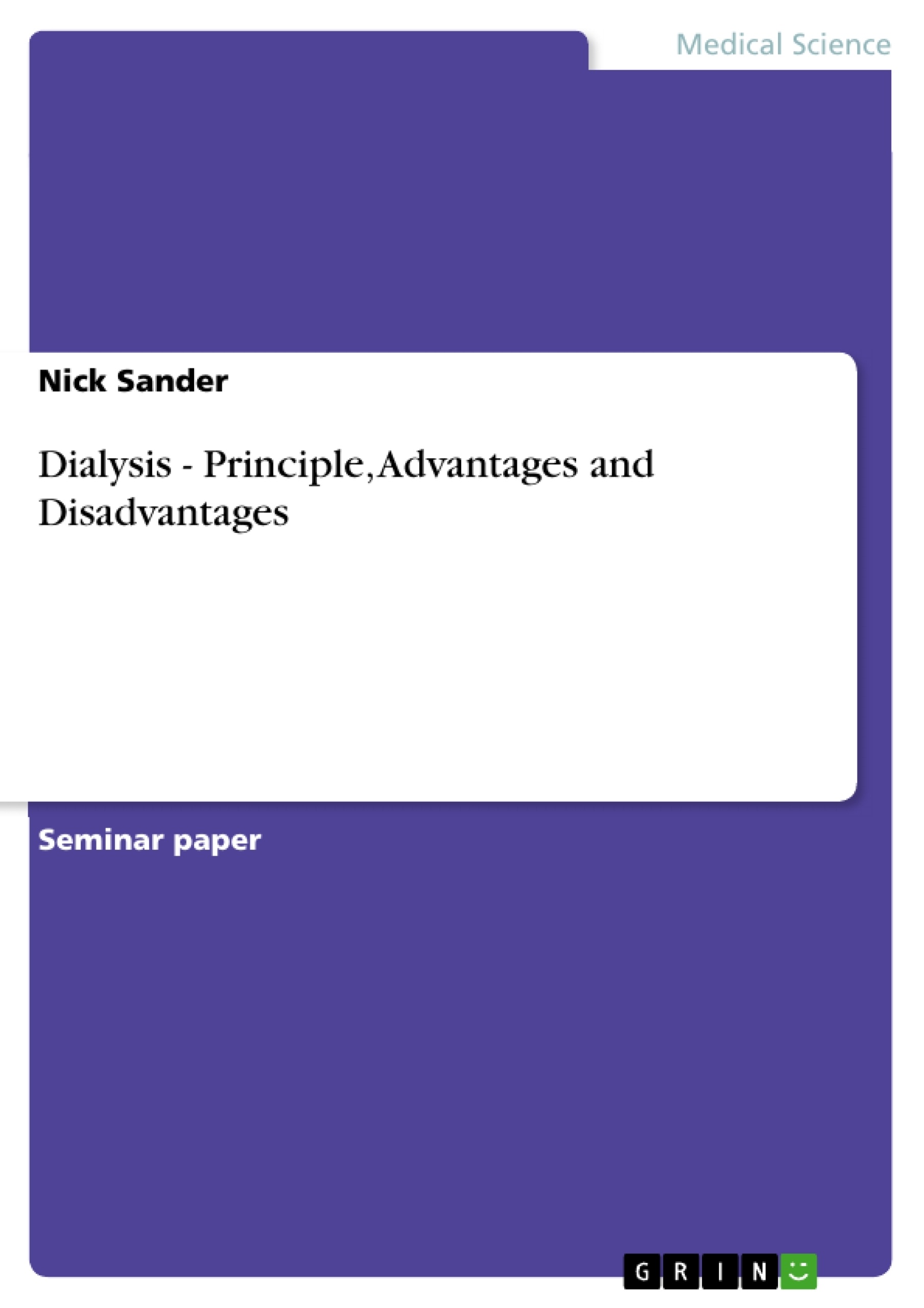Diseases of the kidney like glomerulonephritis, pyelonephritis and polycystic kidneys can constrain the function of the kidney, depending on the type of disease a kidney failure can occur. When kidneys stop working or when less than 15% of the kidneys are working this is called kidney failure. As a result toxic substances as for example urea are accumulated in the body, this leads to symptons such as headache, loss of appetite and high blood pressure. The two main reasons of kidney failure are Diabetis and high blood pressure. So especially all diabetics have to take care of screening for complications every year. In this thesis Dialysis, the treatment of kidney failure, and the principle that is behind it will be discussed in detail.
Table of Contents
- 1 Introduction
- 1.1 Function of the kidneys
- 1.2 Renal Failure
- 1.3 History
- 2 Dialysis
- 2.1 Principle
- 2.2 Hemodialysis
- 2.3 Peritoneal Dialysis
- 2.4 Advantages and Disadvantages
- 2.5 Complications of Dialysis
- 2.6 Alternative: kidney transplantation
- 3 Conclusion
Objectives and Key Themes
This seminarthesis aims to provide a basic understanding of dialysis as a treatment for kidney failure. It explores the function of healthy kidneys, the causes and symptoms of renal failure, and the history of dialysis. The paper also delves into the principles and different types of dialysis, discussing their advantages, disadvantages, and potential complications.
- The function of healthy kidneys and their role in maintaining bodily equilibrium.
- The causes and consequences of renal failure, including its symptoms and prevalence.
- The principles and methods of dialysis, including hemodialysis and peritoneal dialysis.
- The advantages and disadvantages of different dialysis techniques.
- The historical development of dialysis and its impact on kidney failure treatment.
Chapter Summaries
Chapter 1: Introduction: This introductory chapter establishes the foundation for understanding dialysis. It begins by explaining the crucial role of healthy kidneys in maintaining the body's mineral and water balance. The chapter then shifts to a discussion of renal failure, outlining the various diseases that can lead to this condition and detailing its symptoms, such as headaches, appetite loss, and high blood pressure. Diabetes and high blood pressure are identified as major causes of kidney failure. Finally, the chapter concludes with a brief historical overview of dialysis, highlighting the invention of the first dialyzer by Dr. Willem Kolff during World War II.
Keywords
Kidney function, renal failure, dialysis, hemodialysis, peritoneal dialysis, kidney transplantation, Dr. Willem Kolff, urea, blood pressure, diabetes.
Frequently Asked Questions: Dialysis - A Comprehensive Overview
What topics are covered in this document?
This document provides a comprehensive overview of dialysis, including an introduction to kidney function and renal failure, a detailed explanation of different dialysis types (hemodialysis and peritoneal dialysis), their advantages and disadvantages, potential complications, and a brief history of dialysis. It also outlines the objectives and key themes of the document and provides chapter summaries.
What is the purpose of this document?
The main objective is to give a basic understanding of dialysis as a treatment for kidney failure. It aims to explain the role of healthy kidneys, the causes and symptoms of renal failure, and the different methods of dialysis.
What are the key themes explored in the document?
Key themes include the function of healthy kidneys, the causes and consequences of renal failure, the principles and methods of hemodialysis and peritoneal dialysis, the advantages and disadvantages of different dialysis techniques, and the historical development of dialysis.
What are the different types of dialysis discussed?
The document discusses hemodialysis and peritoneal dialysis, explaining the principles behind each method.
What are the advantages and disadvantages of dialysis?
The document outlines the advantages and disadvantages of both hemodialysis and peritoneal dialysis, although specific details aren't provided in this preview.
What are some potential complications of dialysis?
While not detailed in this preview, the document mentions that potential complications of dialysis are discussed within the full text.
What is the historical context of dialysis mentioned in the document?
The document briefly touches upon the history of dialysis, highlighting the invention of the first dialyzer by Dr. Willem Kolff during World War II.
What are the causes of renal failure mentioned?
The preview mentions diabetes and high blood pressure as major causes of kidney failure.
What are the symptoms of renal failure mentioned?
The preview mentions headaches, appetite loss, and high blood pressure as potential symptoms of renal failure.
What keywords are associated with this document?
Keywords include: Kidney function, renal failure, dialysis, hemodialysis, peritoneal dialysis, kidney transplantation, Dr. Willem Kolff, urea, blood pressure, diabetes.
What is included in Chapter 1: Introduction?
Chapter 1 introduces the function of healthy kidneys, explains renal failure, its causes and symptoms, and provides a brief history of dialysis, mentioning Dr. Willem Kolff's invention of the first dialyzer.
What is included in Chapter 2: Dialysis?
Chapter 2 delves into the principles of dialysis, specifically hemodialysis and peritoneal dialysis, comparing their advantages and disadvantages, and discussing potential complications. It also mentions kidney transplantation as an alternative.
What is included in Chapter 3: Conclusion?
The preview does not provide details about the content of the conclusion.
- Citation du texte
- Nick Sander (Auteur), 2010, Dialysis - Principle, Advantages and Disadvantages, Munich, GRIN Verlag, https://www.grin.com/document/153485



